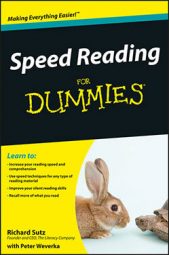Speed reading up to 16 words at a glance is possible because when you read most words, you don’t see the letters in the words or the words per se. What you see on the page are shapes or images that you recognize from your past reading experience — that is, the words are in your vocabulary.
The only time you actually see a word and examine all its letters is the first few times you encounter it. You have to examine the letters closely and commit the word to memory. After it becomes a part of your vocabulary, you can recognize its shape. You can identify and process it quickly as part of a clump in the course of your reading.
In 1976, Graham Rawlinson, a researcher at Nottingham University, conducted an experiment to uncover what information readers get from letters and words when reading. He had volunteers read sentences in which the letters in the words were jumbled except for the first and last letters.
What Rawlinson discovered was surprising: People could read and comprehend the jumbled words almost as easily as unjumbled words. The experiment showed, Rawlinson wrote in New Scientist magazine, “that randomising letters in the middle of words had little or no effect on the ability of skilled readers to understand the text.”
Try this experiment yourself. Read the following paragraphs at normal speed. See whether you can understand the words as easily as you can understand words that aren’t jumbled.
Rseaerch icntidaes taht the oerdr of the ltteers in a wrod dnsoe’t mettar. Waht relaly mtteras is the frist and lsat leettr in the wrod. If tehy are in the rhgit palce, you can raed the wdors.
Wehn you raed, you dno’t raed evrey leettr in ecah wrod. You look at the wrod as a wlohe.
If you’re a typical reader, you were you able to read the paragraphs without any trouble. This experiment suggests that
You read words as a whole when you read, not letter by letter.
The first and last letter of a word may be the most important letters for recognizing a word because these letters define the word’s shape more than the others, and word shapes matter in reading.
Context plays a role in reading. The words on either side of a word provide meaning to the word, and you can often tell what a word means by reading the words beside it.
If a word is familiar to you, you’re capable of recognizing it even if it’s misspelled.
This example shows you that to some degree, reading words is just recognizing shapes.

